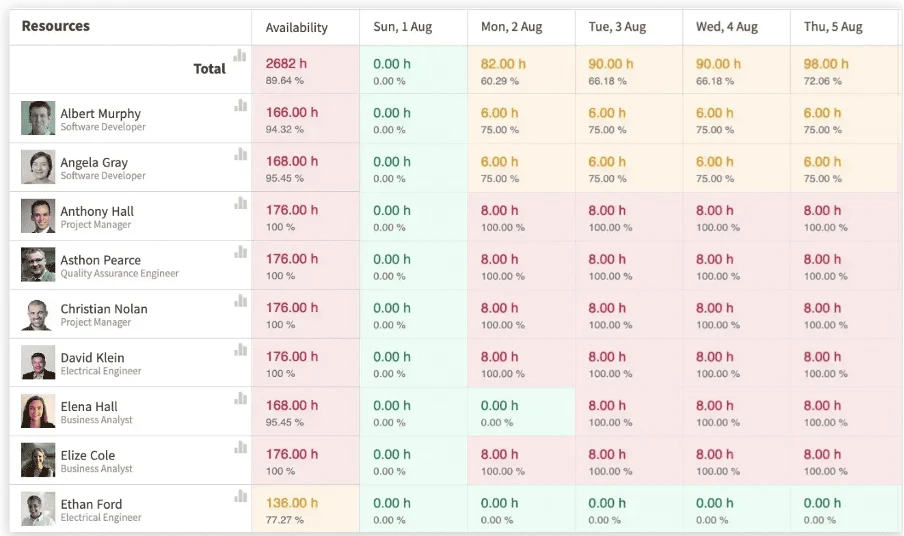
In order for a project to be termed “successful” it has to meet its deliverables, be on-time and on-budget. But, how does one even start to put a timeline and align costs to a project?
That’s where resource analysis comes in.
This tricky word can throw even the most experienced project managers off their guard, but it’s a vital step that can’t be overlooked. It helps you plan your project well and to keep track of project performance. It can also help you plan ahead and schedule activities more effectively.
Luckily, resource analysis is not as complicated as it sounds.
In this guide, we explore what is resource analysis and identify the best way to do one for your business.
Resource Analysis is the process of identifying and evaluating all the resources that are available to achieve an objective or deliver a project.
It’s a crucial step in any project, especially when one needs to identify how long a project will take and calculate the associated costs. Resource analysis will help you make better decisions.
Resources analysis uses data, about its people, to construct a project pipeline.
Picture this scenario — you are overseeing a construction of an office and realise half way that the main civil engineer is on a three week leave or that you don’t have enough manual labor to finish the flooring. You’d probably scramble to hire a temporary engineer and workers at double the rate to ensure the office can be handed over to the client on time. The increased costs can put a substantial burden on the company if even the project gets delivered.
This example can occur in any project, actually. If there is a lack of transparency in regards to which people are available, then a project can get delayed or indefinitely stopped. This is why resource and capability analysis is a powerful tool — one that can predict and help prevent potential project mishaps and failures.
Resource analysis also bridges the gap between having valuable resources and using them wisely and efficiently. It will also help you as a project manager or business owner identify your competencies and which resources you might need in the future.
Resource analysis can help you:
Resource analysis and planning is vital because right resource management is one of the essential indicators for project success.
So, how does one do resource analysis?
Here are six steps you need to follow to do a thorough resource analysis.
The first step is to understand and analyse your existing resource pool. How can one do this? Get information about all the resources and their skillset, location, work preferences and availability in a single place. This has to be done at an organisational level and not by locations or departments.
By analysing the resource pool, you’ll be able to get answers to the following questions:
Next step is to compare how the workload assigned compares to the capacity of each resource. Capacity planning reports can help with this assessment. Capacity assessment will aid in reducing any overbooking of resources (which, if commonly done, can lead an organisation down the rabbit hole of increasing employee dissatisfaction and high attrition).

Furthermore, you should also look into how much time is spent on each task. Is it being completed in the stipulated time or does the allocated time need alteration?
Utilisation rates, at all levels like project, team or location, show you how many hours of your team's work are billable versus non-billable. For example, when someone is assigned to admin work, this work can’t be billed and is not adding to the profit line.
Resource analysis will help you see if your team is meeting the required utilization rates. If everyone has a high utilisation rate, and tasks are still pending, then you know that more resources have to be added.
Studying resource utilisation rates will also provide visibility into your project(s). The more transparency and the better you monitor your project, the more likely you’d be to catch risks before they develop into problems that could sidetrack the final status.
A smart resource allocation strategy is to create “placeholders” in situations where the right resource can’t be identified immediately. By doing this you will be able to pinpoint what the missing pieces of the project puzzle are and fill them in.
A common error in resource analysis and planning is that a manager can see fragmented pieces of information — could be by project stage or by location — but the ability to see the entire matrix is not there.
By using a single-screen and enterprise based resource planning software, a project manager can actually see the larger picture. eRS’s single screen, multipurpose dashboard can provide all right information at your fingertips — one will be able to view everyone's capacity, overtime, and remaining availability.
We’d all want our projects to work without any unexpected situations, but that can be wishful thinking. Project conditions and demands can change to a multitude of things — circling back to our construction example, prices of material can change or a utility outage can delay delivery.
The best way to tackle such “what-if” situations is to have your resource analysis process include forecasting. By forecasting, via a resource allocation system, the project manager can see how the project will get impacted if there’s a change in resources, new work gets added or costs increase.
Resource analysis can seem daunting, but when done with the aid of the correct tools, it becomes easier over time.
eResource Scheduler can make resource analysis a whole lot easier and simpler for you and your team.
eResource Scheduler, or eRS, is a software designed for efficient resource planning and resource allocation. eRS’s resource utilisation feature tracks how resources are working throughout the project’s timeline to ensure that the project is completed on time and within budget.
eRS resource allocation tool helps managers track the billable hours, costing, and resource capacity during projects. Delays and overspending in some of the tasks of a project can indicate risks of missed deadlines or unprofitability, and eRS can help you minimize those errors.
We invite you to experience how eRS can demystify resource analysis for you. Sign up for a free test drive of the product, today!
Also read:
Plan Smarter. Schedule Faster.
Join thousands already using eResource Scheduler to align teams, time, and tasks seamlessly.